Table of Contents
Executive Summary
This case study highlights our hybrid content strategy at BrightBid, a Swedish adtech company delivering an AI-powered platform for Google and Bing Ads optimization. We combine AI insights with our human expertise to help businesses maximize bidding efficiency, optimize ad spend, and improve ROI across industries.
From January to September 2025, we developed content leveraging Large Language Models (LLMs) and AI Overviews (AIO) to inform ideas and structure, while applying rigorous human oversight to ensure authority, accuracy, and SEO effectiveness. Through an A/B test comparing fully human-driven content with LLM-assisted drafts, we confirmed that:
- SEO and LLM visibility are not isolated landscapes; they complement each other.
- Success in search and AI-driven traffic depends primarily on content fundamentals, not the origin of the text.
Enhance your PPC campaigns
The Challenge
With AI-powered search evolving rapidly, traditional SEO metrics like impressions and clicks are no longer sufficient. BrightBid needed to create content that not only ranks well organically but also appears in AI Overviews and drives LLM-referred traffic. The key question: can AI-assisted content outperform classic human-driven content, or is human expertise still the critical factor?
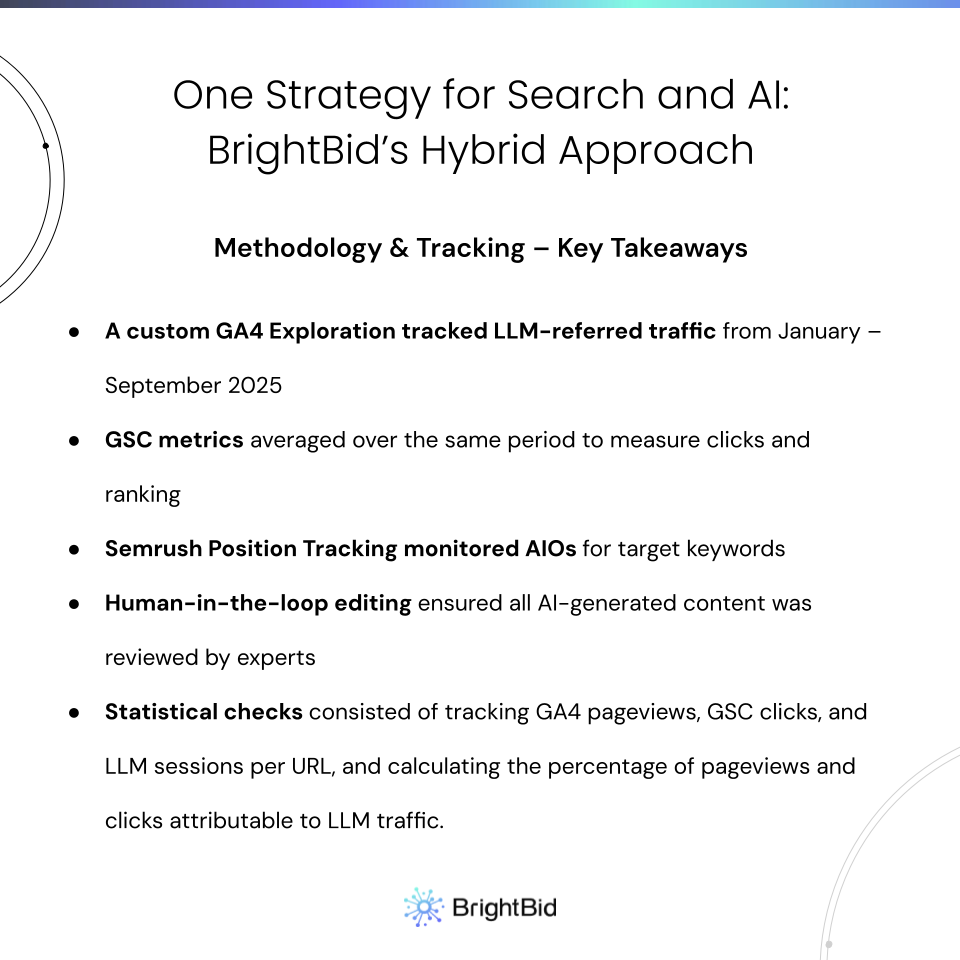
Methodology
- Content Frameworks:
- Framework 1 (Classic Content): Human-led, research-heavy, narrative-driven.
- Framework 2 (LLM-Assisted Content): AI-generated drafts refined by human experts, using AEO playbooks, chunking, and fan-out queries.
- Human-in-the-Loop Editing: All AI-generated content was reviewed for accuracy, citations, structure, readability, and alignment with brand voice and SEO best practices.
- LLM/AIO Optimization: Structured answers, bullet points, subheadings, schema markup, and rich media.
- Performance Tracking:
- Google Search Console (GSC): Clicks and average position.
- Semrush Position Tracking: Keyword ranking and AIO presence.
- Google Analytics 4 (GA4): Total pageviews and LLM-referred sessions filtered by source.
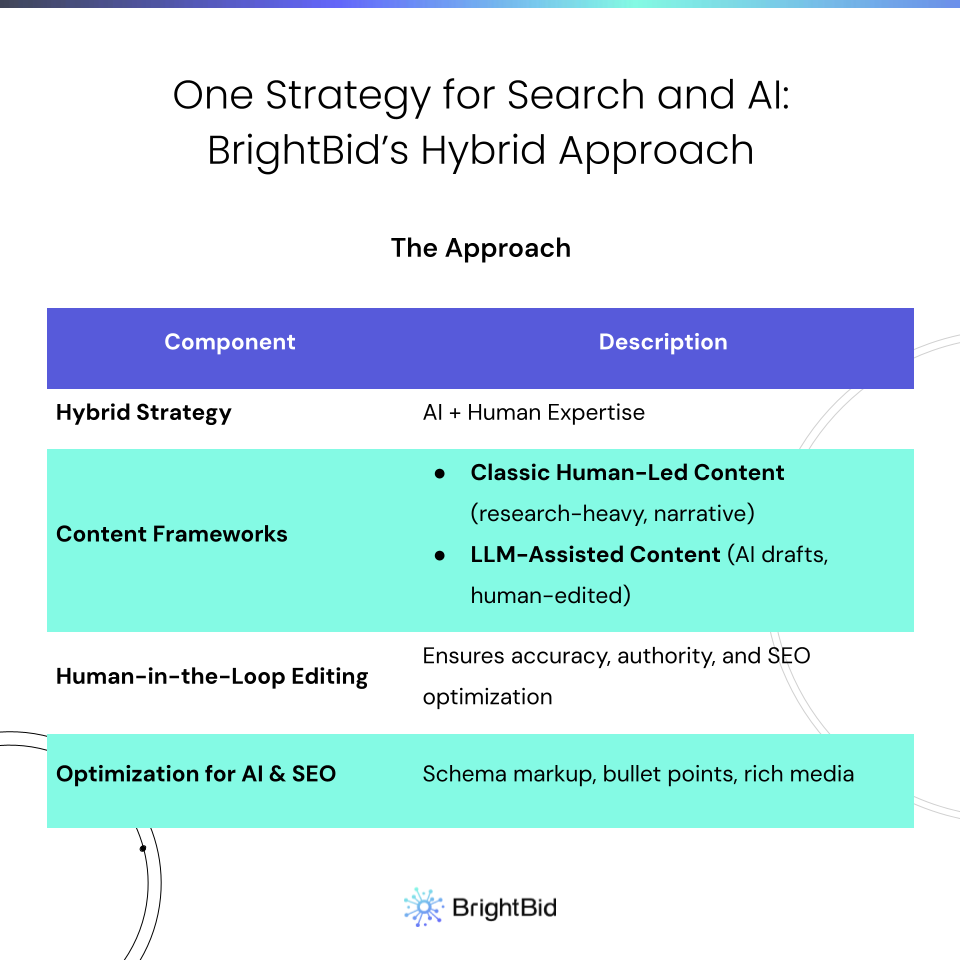
Key Findings
LLM Traffic and Engagement
| URL | GA4 Pageviews | GSC Clicks | GSC Avg. Position | LLM Sessions | Engagement Rate (LLM) |
| Google Ads vs Bing Ads: What is the Difference and Why Use Both in 2025? | 917 | 949 | 21.1 | 579 | 42.8% |
| 10 Ways AI and PPC Automation Can Boost Your Ad Campaigns in 2025 | 108 | 61 | 41.4 | 45 | 32% |
| Understanding Meta Ads to Reach Your Target Audience | 413 | 706 | 21.1 | 358 | 36.8% |
| AI-Driven Customer Segmentation: How to Target the Right Audience | 76 | 57 | 28 | 15 | 33.3% |
| Mastering Performance Max: A Deep Dive into 2025 Analysis & Optimization | 315 | 638 | 30.9 | 260 | 50% |
LLM Traffic as a Percentage of GA4 Pageviews and GSC Clicks
NOTE: All posts periodically get featured in Google’s AIOs.
- LLM traffic can be a substantial portion of total pageviews: Pages like /understanding-meta-ads-reach-target-audience/ (86.7%) and /how-to-analyze-performance-max-campaigns/ (82.5%) show that AI-friendly, structured content can attract the majority of views from LLM referrals.
- LLM sessions do not always align with traditional search clicks: For example, /10-ways-to-improve-ppc-ads-with-ai-and-automation/ had 41.7% of GA4 pageviews from LLMs but 73.8% of GSC clicks came from LLM traffic, highlighting that AI-driven channels can amplify engagement independently of organic rankings.
- LLM traffic can constitute a substantial share of total pageviews, particularly for concise, structured, AI-friendly content.
- Engagement rates indicate high relevance of AI-referral content.
- Pages with moderate organic rankings can still receive significant LLM sessions, highlighting AIOs as an independent discovery channel.
Enhance your PPC campaigns
Human-in-the-Loop Advantage: A/B Test Results
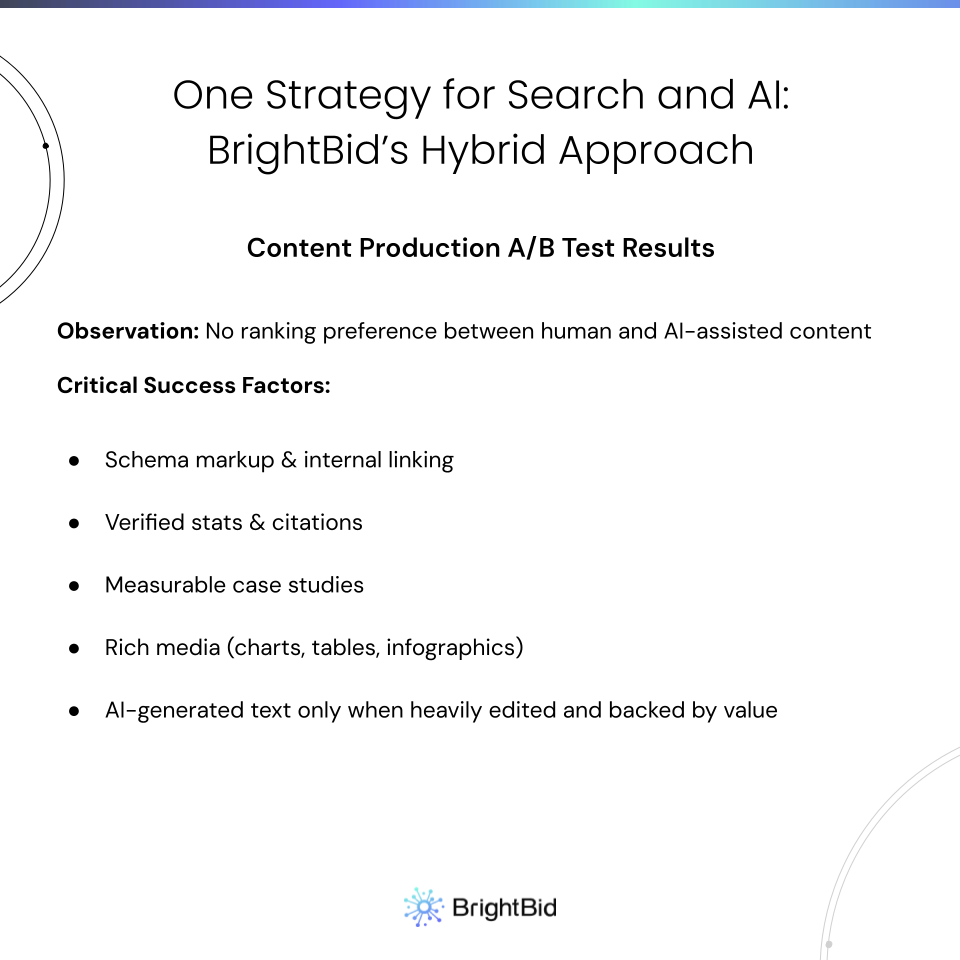
- Observation: No ranking preference between classic human-driven content and LLM-assisted content.
- What was done across both frameworks:
- Schema markup for rich results
- Internal linking to build topical authority
- Verified stats and citations
- Measurable case studies
- Rich media (infographics, tables, charts)
- AI-generated text only when:
- heavily edited by a human expert
- backed by manually adding value, e.g., stats, product offering, etc.
- Implication: AI is a productivity and ideation tool, but human expertise remains essential for accuracy, authority, and SEO performance.
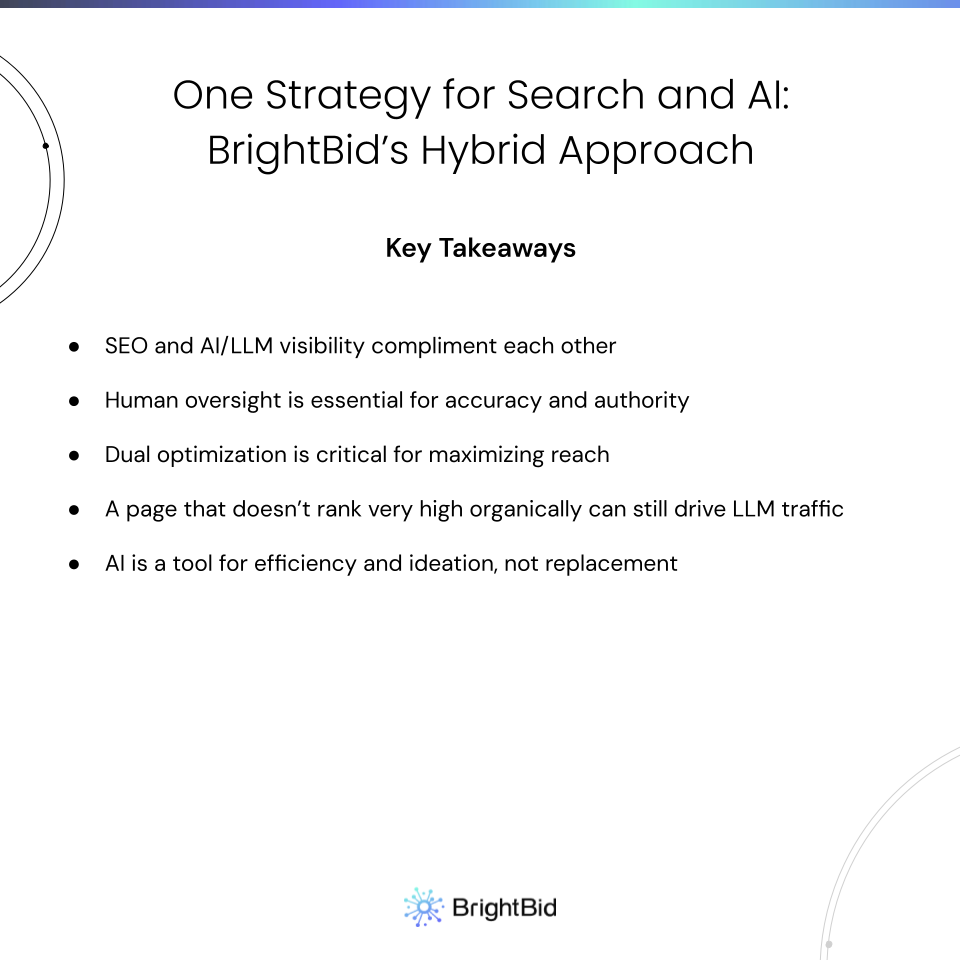
AI Overview (AIO) Presence
- Content appeared in distinct AIO SERP features.
- Top AIO keywords: “ai and customer segmentation” and “ai customer segments” (Semrush AIO rank #1, visibility score 1.27).
- Other AI-friendly keywords like “ai for ppc” also achieved AIO visibility.
Insights
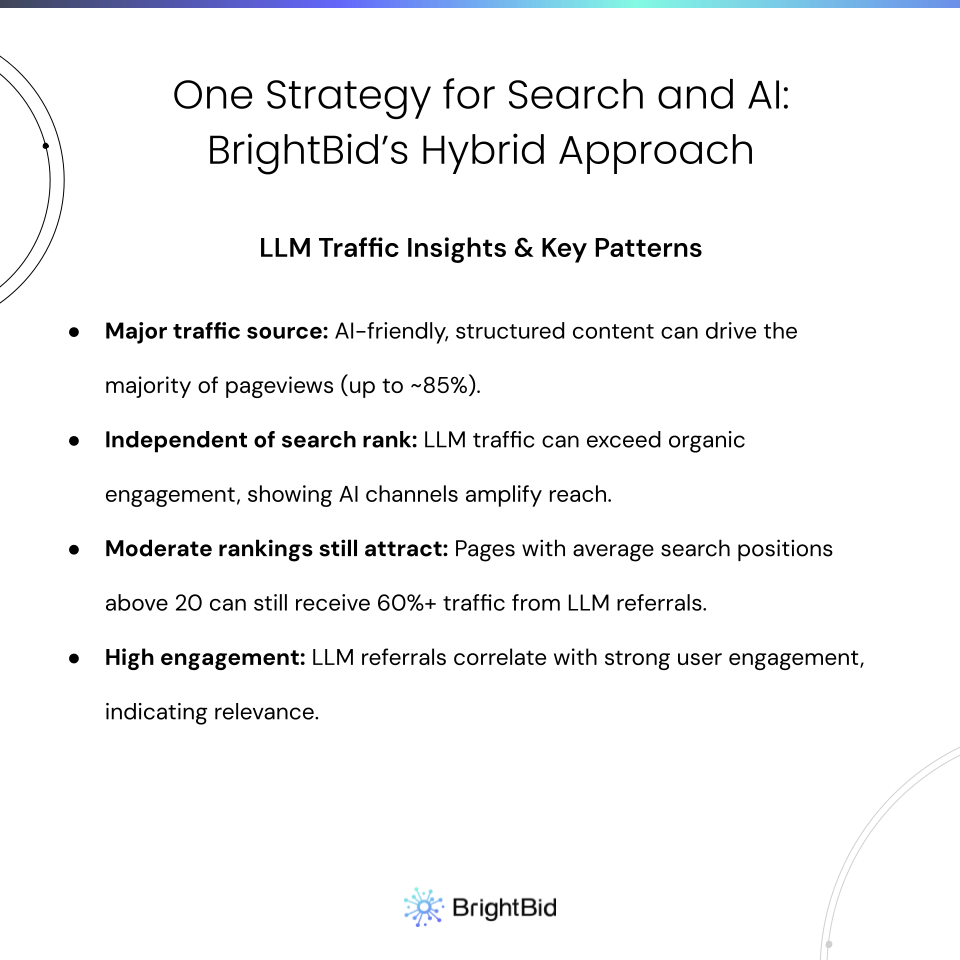
- Success in both traditional SEO and AI-driven traffic relies on content fundamentals, not content origin.
- LLM referrals provide an independent traffic channel that can elevate pages with moderate organic rankings.
- Human-in-the-loop editing ensures content is trustworthy, accurate, and authoritative, which is critical for Google’s search algorithms, AI consumption and human readership.
- Dual optimization (traditional + AI/LLM search) is necessary for comprehensive visibility.
Comparison with Other Studies
- Google Search Central notes AI features and Overviews can surface content outside top-10 organic positions (Google, 2025).
- Semrush reports structured, concise answers are critical for AI visibility (Semrush, 2025).
- Diggity Marketing documented increases in AI-referral traffic for answer-focused content (Diggity, 2024).
- GA4 source filtering and server log verification are recommended for accurate AI session attribution (Orbit Media, 2024).
Conclusion
This case study demonstrates that:
- Human oversight is critical: AI assists with efficiency, but authority, accuracy, and SEO fundamentals drive real results.
- Both content frameworks can succeed: Classic human content and LLM-assisted drafts achieve high rankings and AI visibility if fundamentals are applied.
- AI-friendly content captures independent traffic: Structured, concise, answer-focused content attracts high-quality LLM sessions even when organic rankings are moderate.
- Dual-channel optimization is essential: Content must serve both traditional searchers and AI-driven discovery to maximize visibility and engagement.
BrightBid’s approach proves that integrating AI as a tool—not a replacement—allows adtech brands to thrive in the evolving AI-driven search ecosystem.
Methodology & Tracking
- A custom GA4 Exploration, filtering sessions from sources like ChatGPT, Perplexity, and Copilot, over the period January–September 2025.
- GSC: Clicks and average position averaged over January – September 2025.
- Semrush Position Tracking for AI Overview appearances for target keywords during January – September 2025.
- Human-in-the-loop editing: All AI-generated content reviewed by subject matter experts.
- Statistical checks consisted of tracking GA4 pageviews, GSC clicks, and LLM sessions per URL, and calculating the percentage of pageviews and clicks attributable to LLM traffic.
Enhance your PPC campaigns
FAQ: Human-in-the-Loop Content Strategy for AI & Search Visibility – BrightBid
1. What is the human-in-the-loop content strategy?
It is a hybrid approach where AI (LLMs) assists with content creation, ideation, and optimization, while humans review, edit, and enhance the content to ensure accuracy, authority, and SEO effectiveness. AI is only used when:
- Heavily edited by a human expert
- Backed by real value (e.g., verified stats, product insights, actionable recommendations)
2. Why did BrightBid implement this strategy?
The goal was to optimize content for both traditional search engines (SEO) and AI-driven discovery channels (LLMs and AI Overviews) while maintaining trustworthiness and authority. This ensures content attracts high-quality traffic and supports brand credibility.
3. How does AI contribute without replacing human expertise?
AI helps generate drafts, propose content structures, and identify relevant keywords or queries. Human experts then refine these drafts, verify facts, enhance clarity, and add brand-specific insights, ensuring that the content is both accurate and authoritative.
4. What were the two content frameworks tested?
- Classic Content: Fully human-created, research-heavy, narrative-driven.
- LLM-Assisted Content: AI-generated drafts edited by humans using AEO playbooks, chunking, and query fan-out.
5. What did the A/B test reveal?
Both frameworks could achieve high organic search rankings and AI visibility. The determining factors for success were SEO fundamentals, structured content, and human oversight, not whether AI created the initial draft.
6. How was content optimized for AI and LLMs?
- Structured answers and bullet points
- Subheadings and concise formatting
- Schema markup for rich results
- Rich media (infographics, charts, tables)
- Verified stats and citations
7. What metrics were used to measure performance?
- GA4: Pageviews and LLM-referred sessions
- GSC: Clicks and average position
- Semrush AIO: Presence in AI Overview SERP features
- Statistical tests for engagement and session quality
8. How did LLM traffic compare to total pageviews?
LLM sessions were a significant portion of total pageviews for AI-friendly, structured content. For example, the Google vs. Bing Ads article had 917 GA4 pageviews and 579 LLM sessions, with 42.8% engagement rate.
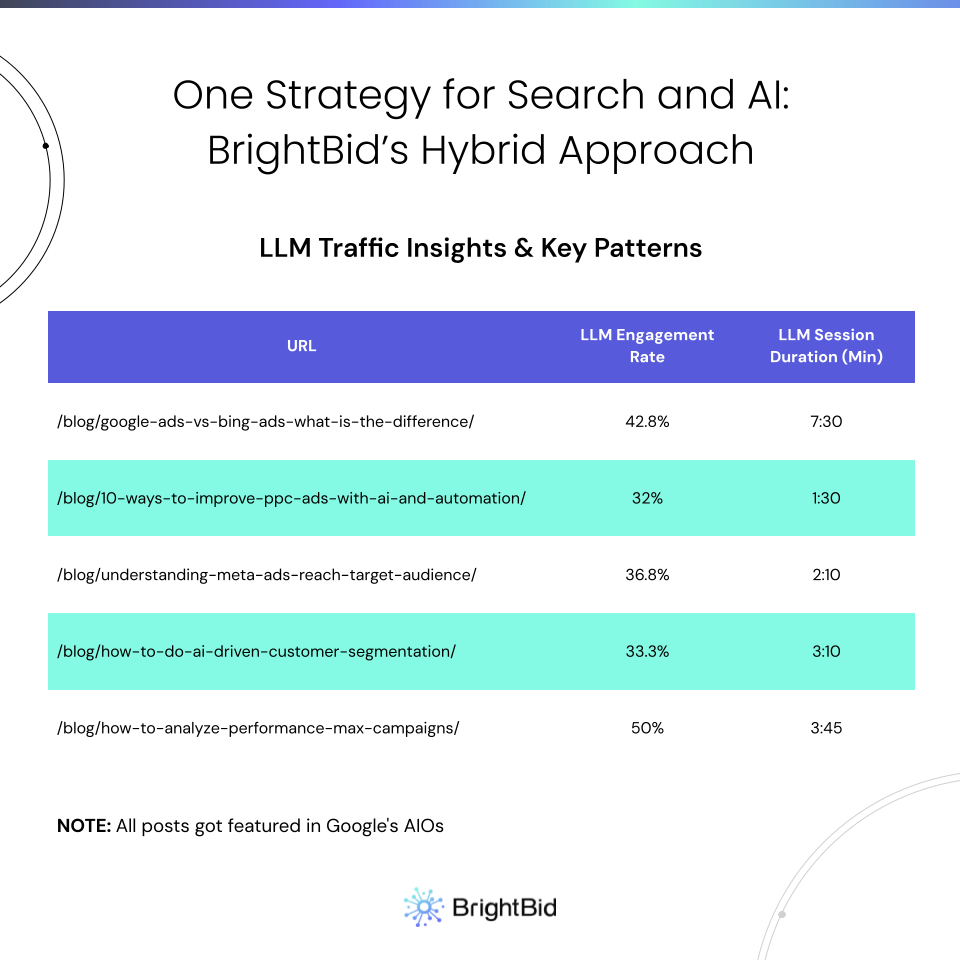
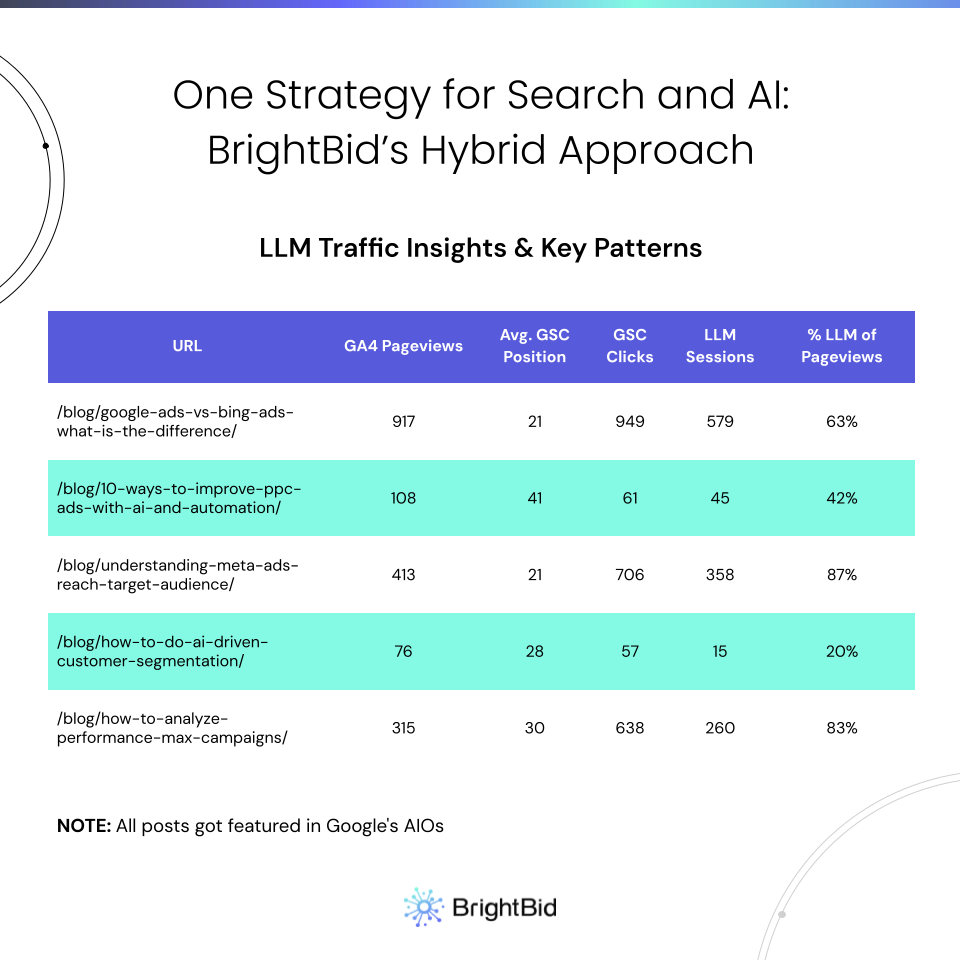
9. What insights were gained about SEO vs. LLM visibility?
- SEO and LLM visibility complement each other; they are not mutually exclusive.
- AI-friendly content can generate high-quality traffic even for pages with moderate organic ranking.
- Human-in-the-loop editing ensures content is authoritative for both human readers and AI algorithms.
10. What are the key takeaways?
- Human oversight is critical: AI supports efficiency but does not replace authority.
- Both content frameworks succeed if fundamentals are applied.
- Structured, AI-optimized content captures independent traffic from LLMs.
- Dual optimization for traditional SEO and AI-driven search is essential for full visibility.
 ” />
” />
 ” />
” />
 ” />
” />
 ” />
” />
 ” />
” />
 ” />
” />